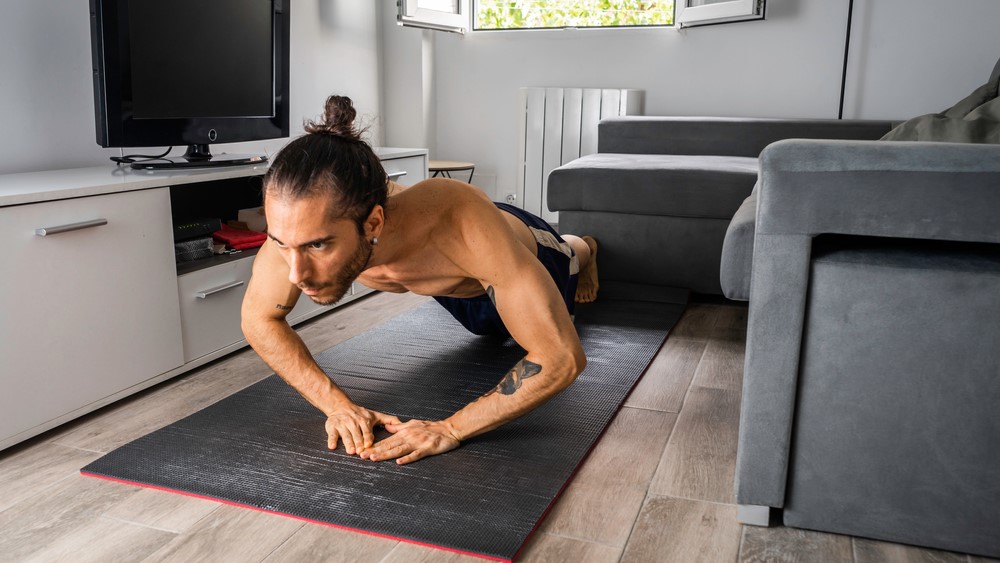
Compound exercises get mentioned all the time in fitness, usually in the same breath as functional training. And while the two go hand in hand, it’s beneficial for any exerciser to know the difference.
If you’re trying to work out which is better for building strength and muscle — isolation vs compound exercises — it comes down to bang for your buck.
Compound exercises recruit multiple muscle groups and joints, and isolation exercises work one muscle group in one plane of movement. For example, a push-up is classified as a compound exercise because it targets the pectoral muscles, anterior deltoids (fronts of the shoulders) and triceps, whereas a hamstring curl primarily works your hamstring muscles in isolation.
Compound exercises are a compact and efficient way to develop muscle mass, strength and power across your entire body without spending hours in the gym.
Below, we cover the many other benefits of compound exercises, how they compare with isolation moves and how to add them to your exercise routine. Grab the best fitness trackers for workouts and read on for more.
What are compound exercises?
As we mentioned, compound exercises work multiple muscle groups. Pull-ups, lunges and squats are all good examples of a compound exercise and sit under the “functional exercise” umbrella, whether you use your body weight or add weights like the best adjustable dumbbells.
Functional workouts use compound exercises and closely replicate daily tasks or movements you’d perform, like climbing, pushing or jumping, which are staples in classes like CrossFit and F45.
Sign up to get the BEST of Tom's Guide direct to your inbox.
Get instant access to breaking news, the hottest reviews, great deals and helpful tips.

10 compound exercise examples
Here are some examples of compound exercises that are suitable for beginners and advanced exercisers. You could select a few exercises to try as a circuit or perform exercises in a traditional resistance training program with sets and reps.
If you're new to any of the exercises, ensure you check your form with a personal trainer. If you're returning from injury, a medical professional should ideally clear you for exercise before you start a new exercise regime.
- Push-up
- Deadlift
- Squat
- Sled push
- Pull-up
- Bentover row
- Lunges
- Overhead press
- Bench press
- Tricep dips
Compound exercises: benefits
Like functional training, compound exercises are a huge part of calisthenics — a type of bodyweight training encompassing gymnastics (here’s a top example of a calisthenics workout for beginners), and the benefits are endless.
Versatile strength and muscle-building exercises
Compound movements are versatile, meaning beginners and more advanced exercisers can benefit from them.
Take the humble squat, for example. Bodyweight squats are brilliant for beginners trying to learn the move and build strength and muscle, jump squats are a plyometric version that helps develop explosive power, and barbell, kettlebell or dumbbell squats are suitable for those developing strength and muscle mass.
Improve flexibility, mobility and agility
Compared with isolation exercises, these multi-joint multi-muscle moves recruit more of your body to work together and could develop flexibility, mobility and agility alongside mobility exercises. Because these moves mimic daily activity, they could help your body move in better harmony.
Burns more calories
An exercise program formed of compound exercises works more muscles during your workout, contributing towards higher calorie burn. Compound exercises added to higher-intensity training that increases your heart rate, like MetCon workouts (these combine cardio, strength training and various intensities), will also ramp up the EPOC process. That’s when your body consumes more oxygen after a workout to return your body to balance, boosting your metabolism.
Moreover, it’s one of the most efficient ways to achieve a full-body workout and improve cardio fitness.
Builds stronger bones and muscles
Resistance training places stress on the bones and stimulates your bone-building cells — called bone loading — crucial for protecting your body from injury. You can also target multiple muscle groups and joints repeatedly without reaching fatigue as quickly.
Isolation exercises focus on one muscle group through its full range of motion, meaning you’ll hit fatigue quicker — great for building your biceps maybe, but not overall full-body strength and muscle.
Coaches will include compound exercises in an athlete's training program for the reasons above and because they teach your body to work as a more efficient machine. Compound exercises require far more core engagement to support your torso through each move and improve your neuromuscular mind-body connection.
The training for CrossFit athletes, Hyrox workouts and other sport-specific training programs will tackle isolation exercises on occasion, but you’ll notice far more compound exercises that help to develop skills specific to their goals.
For example, strength and conditioning coaches working with footballers will work isolation exercises into training but always alongside lower body exercises that will develop explosive power, strength and muscle in the legs as a unit. This will usually involve a mixture of strength exercises like squats, jumps and sprints.
Compound exercises vs isolation exercises
Although compound exercises tick nearly every box, isolation exercises have a purpose. If your goal is to iron out any muscular imbalances or build strength and muscle in one area, isolation exercises are a great way to achieve it.
For example, bicep curls will help develop your bicep muscles, which could also benefit other exercises like pull-ups or rows. Honing one muscle group allows you to focus on form without other muscle groups in play.
Isolation exercises are also crucial for injury rehabilitation if you need to build strength in the injured body part and help keep the body in better balance to avoid injury or overuse.
More from Tom’s Guide: 5 functional workouts to try

If you think you’ve got these moves locked down, try some of these functional workouts recommended by Tom’s Guide:
- 10-minute bodyweight workout builds strength without equipment
- This 300-rep bodyweight workout hits all your muscles
- We swear by this 4-move battle rope workout
- This full-body workout requires one dumbbell
- This kettlebell workout takes only 15 minutes.

Sam Hopes is a level 3 qualified trainer, a level 2 Reiki practitioner and fitness editor at Tom's Guide. She is also currently undertaking her Yoga For Athletes training course.
Sam has written for various fitness brands and websites over the years and has experience across brands at Future, such as Live Science, Fit&Well, Coach, and T3.
Having coached at fitness studios like F45 and Virgin Active and personal trained, Sam now primarily teaches outdoor bootcamps, bodyweight, calisthenics and kettlebells.
She also coaches mobility and flexibility classes several times a week and believes that true strength comes from a holistic approach to training your body.
Sam has completed two mixed doubles Hyrox competitions in London and the Netherlands and finished her first doubles attempt in 1:11.
